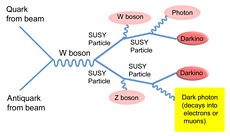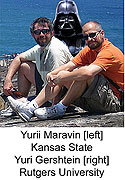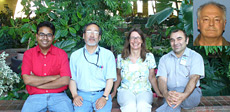Dark photons

In this particular hidden valley model, six particles are created, all indicated by color. The dark photons are shown in yellow. For the other particles, those indicated in light pink will be observed in the detector, while the ones marked with dark pink will escape entirely undetected. If observed, these darkinos might be the dark matter for which astronomers search.
Popular physics abounds with interesting and speculative ideas, with dark matter and dark energy leading the way. Recently another idea has surfaced with a similar name: dark photons. While evidence suggesting dark matter and energy came from measurements in space, DZero scientists sought to find evidence for dark photons in their detector.
We know a lot about the familiar photons, quarks, electrons and other particles that make up ordinary matter because they interact strongly with each other. Scientists can even observe the ghostly neutrino. But there remains the possibility that other particles exist that interact much more weakly. Ideas that explore this hypothesis are called “hidden valley” models, a particle Shangri La that has remained thus far undetected.
There are several hidden valley models, including one specific model that incorporates the principle of supersymmetry and was recently studied. In this model, a complicated decay signal could reveal signs of a dark photon. In an example collision in which a dark photon might be created, a W boson creates two gauginos, the supersymmetric equivalent to the common W and Z boson. These two particles decay into six separate particles: a W and Z boson, a photon, two darkinos and a dark photon. The darkinos do not interact with the detector and escape entirely undetected, while the dark photon can decay into a pair of electrons or muons. The mechanism by which the dark photons decay involves the principles of quantum mechanics. If dark photons exist, they may explain recent astronomical measurements that claim to have found more antimatter electrons than expected.
DZero physicists searched this Web page for events with a photon, missing energy (the escaping darkinos) and an electron or muon pair. The associated W and Z bosons were not specifically required to be observed in this study. Only a handful of events with these characteristics were seen, and the number observed was consistent with the Standard Model.
The scientists concluded that the data did not support the dark photon hypothesis, although its existence cannot be completely ruled out if the supersymmetric chargino is heavy. While a confirmation of a new theory is very exciting, to rule out an idea (or even a part of an idea) is also crucial. Knowing what is not true rules out possibilities and tells physicists where to focus efforts.
I think it’s safe to say that DZero has once again shed light on the dark.
-- Don Lincoln
 |
Yurii Maravin and Yuri Gershtein performed this dark photon analysis, further exploring the dark side of the subatomic universe. |

Efficiently detecting muons is a crucial component of this analysis. These physicists operate the DZero central muon detector and trigger systems and continuously strive to maintain optimum performance. Left to right: Amitabha Das, University of Arizona; Al Ito, Penny Kasper and Norik Khalatyan, all from Fermilab. (Inset: Ivan Kiselevich, ITEP, Russia)
|